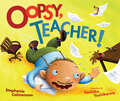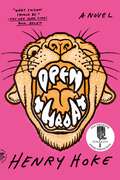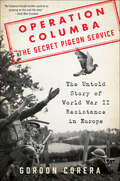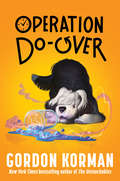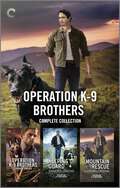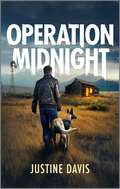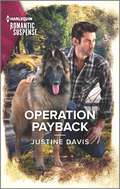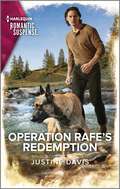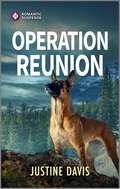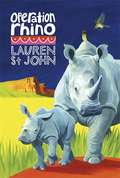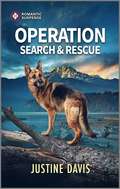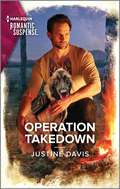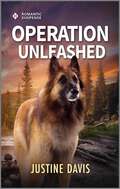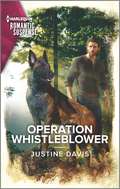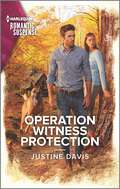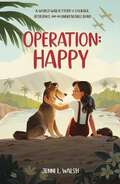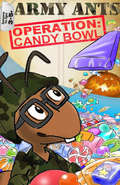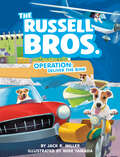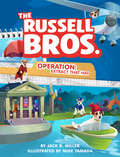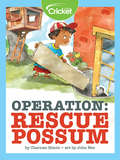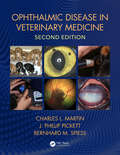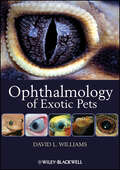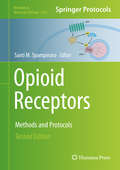- Table View
- List View
Oopsy, Teacher!
by Stephanie Calmenson Sachiko YoshikawaEven the best teachers can have an oopsy day. Sometimes things just don't go their way. Uh-oh! Mr. Bungles drips jam on his tie at breakfast. His students play a trick on him at school. And the class hamster, Nibbles, escapes from his cage! Mr. Bungles and the class chase Nibbles through the halls and into town. But can they catch the hamster?
Open Throat: A Novel
by Henry HokeFinalist for the PEN/Faulkner Award, the Barnes & Noble Discover Prize, and the James Tait Black Prize for Fiction. One of the Washington Post's 50 Notable Works of Fiction in 2023. One of The New York Times' 10 Best California Books of 2023. “Open Throat is what fiction should be.” —The New York Times Book ReviewA lonely, lovable, queer mountain lion narrates this star-making fever dream of a novel.A queer and dangerously hungry mountain lion lives in the drought-devastated land under the Hollywood sign. Lonely and fascinated by humanity’s foibles, the lion spends their days protecting a nearby homeless encampment, observing hikers complain about their trauma, and, in quiet moments, grappling with the complexities of their gender identity, memories of a vicious father, and the indignities of sentience. When a man-made fire engulfs the encampment, the lion is forced from the hills down into the city the hikers call “ellay.” As the lion confronts a carousel of temptations and threats, they take us on a tour that spans the cruel inequalities of Los Angeles and the toll of climate grief. But even when salvation finally seems within reach, they are forced to face down the ultimate question: Do they want to eat a person, or become one?Henry Hoke’s Open Throat is a marvel of storytelling, a universal journey through a wondrous and menacing world recounted by a lovable mountain lion. Feral and vulnerable, profound and playful, Open Throat is a star-making novel that brings the mythic to life.
Operation Columba—The Secret Pigeon Service: The Untold Story of World War II Resistance in Europe
by Gordon Corera“No Frederick Forsyth thriller could be as gripping as this real-life story” of British intelligence, brave WWII resisters, and 16,000 homing pigeons (Daily Mail).Between 1941 and 1944, Britain dropped sixteen thousand homing pigeons in an arc across Nazi-occupied Europe, from Bordeaux, France to Copenhagen, Denmark, as part of a spy operation code-named Columba. Returning to MI14, the secret government branch in charge of the “Special Pigeon Service,” the birds carried messages that offered a glimpse of life under the Germans in rural France, Holland, and Belgium. Written on tiny pieces of rice paper tucked into canisters and tied to the birds’ legs, these messages were sometimes comic, often tragic, and occasionally invaluable—reporting details of German troop movements and fortifications, new Nazi weapons, radar systems, and even the deployment of the feared V-1 and V-2 rockets used to terrorize London.The people who sent these messages were not trained spies. They were ordinary men and women willing to risk their lives in the name of freedom, including the “Leopold Vindictive” network—a small group of Belgian villagers led by an extraordinary priest named Joseph Raskin. The intelligence Raskin sent back by pigeon proved so valuable that it reached Churchill, and MI6 parachuted agents behind enemy lines to assist him.Gordon Corera uses declassified documents and extensive original research to tell this true story for the first time. A powerful tale of wartime espionage, bitter rivalries, extraordinary courage, astonishing betrayal, harrowing tragedy, and a quirky, quarrelsome band of spy masters and their special mission, Operation Columba is, ultimately, a tale of how, in one of the darkest and most dangerous times in history, under threat of death, people bravely chose to resist.“The eccentric idea of enlisting pigeons as spies, combined with the bravery of those in occupied Europe who picked them up, vividly animates Corera’s excellent addition to the annals of WWII espionage.” —Booklist“Witty and meticulously researched.” —Publishers Weekly“Once you’ve read this book you’ll never look at a pigeon disdainfully again . . . .an intoxicating mixture of comedy and high seriousness.” —Daily Mail
Operation Do-Over
by Gordon KormanFrom the New York Times bestselling author of The Unteachables, Gordon Korman, comes a hilarious new high-concept friendship story in the vein of Back to the Future. Perfect for fans of Korman’s Restart. Mason and Ty were once the very best of friends, like two nerdy sides of the same coin . . . until seventh grade, when Ava Petrakis came along. Now Mason can trace everything bad in his life to that terrible fight they had over the new girl. The one thing he’d give anything for is a do-over. But that can’t happen in real life—can it?As a science kid, Mason knows do-overs are impossible, so he can’t believe it when he wakes up from a freak accident and finds himself magically transported back to seventh grade. His parents aren’t yet divorced and his beloved sheepdog is still alive. Best of all, he and Ty haven’t had their falling-out yet.It makes no logical sense, but Mason is determined to use this second chance to not only save his friendship (and his dog!) but do other things differently—like trying out for the football team and giving new friends a chance. There’s just one person he’ll be avoiding at all costs: Ava. But despite his best efforts, will he be able to stop the chain of events that made his previous life implode?
Operation K-9 Brothers Complete Collection
by Sandra OwensNavy SEALS, strong heroines, and the dogs they love: All three books in award-winning author Sandra Owens&’s Operation K-9 Brothers series, available together for the first time!Operation K-9 BrothersNavy SEAL Jack Daniels and his trusty Belgian Malinois sidekick, Dakota, are back home after a bomb left them scarred. He isn&’t looking for is a permanent relationship, but when gorgeous local potter Nichole Masters feels like she&’s being watched, Jack is the only person she can turn to. Accepting his protection is one thing—Nichole didn&’t count on falling in love.Keeping GuardNavy SEAL Noah Alba is on extended leave after a terrible mistake resulted in the loss of his K-9 partner. It felt too soon to train another dog until drop-dead gorgeous Peyton Sutton—and her rambunctious rescue dog Lucky—needs his help. Guarding a runaway bride is no way to avoid a simmering attraction. But Peyton can&’t outrun her ex, and Noah can&’t outrun his past.Mountain Rescue Stuntwoman Rachel Denning thought she&’d found the perfect hideout until a strange man appears in her remote cabin. Navy SEAL Dallas Manning is on extended leave and only in town to train service dogs for veterans. Finding his mountain retreat occupied by a gorgeous knife-wielding stranger isn&’t part of his plan. All he wants is to be left alone to get his head straight, but Rachel stirs his protective instincts… Look for the complete Operation K-9 Brothers series by Sandra Owens!
Operation Midnight: A Thrilling K-9 Suspense Novel (Cutter's Code #1)
by Justine DavisAn undercover mission and a mysterious dog guide two people toward safety…and true love in this Cutter&’s Code romance from award-winning author Justine Davis.A desperate operation…and fiery, secret passion!Hayley Cole is taken, along with her dog Cutter, by armed men in a black helicopter. What do they want with her? And why is her usually savvy dog so friendly toward their lean, dark-haired leader Quinn Foxworth? Hayley knows she should be trying to escape. But Quinn, with his intense, searching gaze, is always three steps ahead—and much, much too close.Quinn Foxworth needs to keep Hayley safe, and the only way he knows how is to take control of the situation. Grabbing Hayley is the only way his undercover witness-protection team can protect her as well as their client, but he's tempted by her innocent courage. Can he convince her he's one of the good guys while keeping her at arm's length? Or will he risk letting Hayley into his heart for good?Previously PublishedRead Justine Davis's Cutter's Code series from the beginning! Book 1: Operation Midnight Book 2: Operation Reunion Book 3: Operation Blind Date Book 4: Operation Unleashed Book 5: Operation Power Play Book 6: Operation Homecoming...and more!
Operation Payback (Cutter's Code #14)
by Justine DavisShe taught him the meaning of love…But will his past ruin their second chance? An abusive home drove Trip Callen into crime—then prison. Only Kayley McSwain recognized the goodness in Trip and stood by him as no one ever had. When Trip and Kayley are targeted by a vengeful criminal syndicate, the Foxworths and their remarkable dog Cutter offer them protection. But can Trip keep Kayley safe and uncover the threat to her life in time?From Harlequin Romantic Suspense: Danger. Passion. Drama.Feel the excitement in these uplifting romances, part of the Cutter's Code series:Book 1: Operation MidnightBook 2: Operation ReunionBook 3: Operation Blind DateBook 4: Operation UnleashedBook 5: Operation Power PlayBook 6: Operation HomecomingBook 7: Operation Soldier Next DoorBook 8: Operation AlphaBook 9: Operation NotoriousBook 10: Operation Hero's WatchBook 11: Operation Second ChanceBook 12: Operation Mountain RecoveryBook 13: Operation WhistleblowerBook 14: Operation Payback
Operation Rafe's Redemption (Cutter's Code #17)
by Justine DavisTo bring down a traitor…She needs the man who betrayed her love!Years ago, Foxworth Foundation operatives walked into a trap that almost annihilated them all. So when Charlie Foxworth—the firm&’s cool financial mastermind—finds the man responsible, she&’ll stop at nothing to take him down. But to do it, she needs unflappable former sniper Rafe Crawford—the man who shattered her heart—plus K-9 Cutter. Little does she know, they also might be key to keeping her alive! From Harlequin Romantic Suspense: Danger. Passion. Drama.Read the Cutter's Code series from the beginning! Book 1: Operation Midnight Book 2: Operation Reunion Book 3: Operation Blind Date Book 4: Operation Unleashed Book 5: Operation Power Play Book 6: Operation Homecoming Book 7: Operation Soldier Next Door Book 8: Operation Alpha Book 9: Operation Notorious Book 10: Operation Hero's Watch Book 11: Operation Second Chance Book 12: Operation Mountain Recovery Book 13: Operation Whistleblower Book 14: Operation Payback Book 15: Operation Witness Protection Book 16: Operation Takedown Book 17: Operation Rafe's Redemption
Operation Reunion: A Murder Mystery Book (Cutter's Code)
by Justine Davis"I thought you were through with me."What does the dog know? When Kayla meets Cutter, the big, brown Belgian, she&’s at a crossroads. She&’s certain she&’s about to clear her brother of her parents&’ murder. But Dane, her longtime love, is just as sure that she&’s wasting her life. One man needs her. The other, apparently, doesn&’t... Although it breaks her heart, the choice is made.Only Dane Burdette isn&’t going anywhere. As loyal as that dog, he still loves the beautiful girl next door, even if her life has been derailed. And when danger comes back to their small town, he knows she – and their love – is at risk. Kayla has made her quest her life. Neither Dane nor Cutter will let it take her life, too.Read more from the Cutter's Code series! Book 1: Operation Midnight Book 2: Operation Reunion Book 3: Operation Search and Rescue Book 4: Operation Unleashed Book 5: Operation Power Play Book 6: Operation Homecoming Book 7: Operation Soldier Next Door Book 8: Operation Alpha Book 9: Operation Notorious Book 10: Operation Hero's Watch Book 11: Operation Second Chance Book 12: Operation Mountain Recovery Book 13: Operation Whistleblower Book 14: Operation Payback Book 15: Operation Witness Protection Book 16: Operation Takedown Book 17: Operation Rafe's RedemptionPreviously Published
Operation Rhino (The White Giraffe Series)
by Lauren St JohnA magical and heartwarming adventure about saving endangered species. When Sawubona’s white rhinos are attacked, the poachers leave behind an orphaned calf. Devastated but determined to help, Martine and Ben agree to take the rhino baby to a sanctuary near the Golden Gate Highlands National Park. But the sanctuary is hiding a precious secret – one that must be guarded from the poachers at all costs. Martine and Ben find themselves in the fight of their lives to save one of the rarest animals on earth. But who do they trust?
Operation Search and Rescue: A Romantic Thriller (Cutter's Code)
by Justine DavisEnjoy this Cutter's Code book, previously published in 2013 as Operation Blind DateA handsome stranger and his dog will help uncover the truth about a missing womanWeeping in front of customers isn&’t Laney Adams&’s style. She would have gone unnoticed if Security expert Teague Johnson hadn't come to her grooming shop to pick up his boss&’s dog, Cutter. Something about Teague--or maybe it's the uncannily perceptive canine--compels her to open up about her best friend who's gone missing and how she feels responsible. The confession reminds Teague of his own secret guilt. He can't turn away. With the help of the Foxworth Foundation—and Cutter—Laney and Teague launch a dangerous search that leads to unexpected twists…and undeniable passion.Read the Cutter's Code series from the beginning: Book 1: Operation Midnight Book 2: Operation Reunion Book 3: Operation Search and Rescue Book 4: Operation Unleashed Book 5: Operation Power Play Book 6: Operation Homecoming Book 7: Operation Soldier Next Door Book 8: Operation Alpha Book 9: Operation Notorious Book 10: Operation Hero's Watch Book 11: Operation Second Chance Book 12: Operation Mountain Recovery Book 13: Operation Whistleblower Book 14: Operation Payback Book 15: Operation Witness Protection Book 16: Operation Takedown Book 17: Operation Rafe's Redemption
Operation Takedown (Cutter's Code #16)
by Justine DavisHunting for justice… With a bodyguard dog. As a powerful family tries to silence him, Jordan Crockett feels more endangered than he ever felt in combat. That doesn&’t stop him from telling Emily Bishop the truth about how her brother—his best buddy—died. When she becomes a target, too, he&’ll do anything to protect her. Luckily, the Foxworths and their incredible dog, Cutter, have his back…From Harlequin Romantic Suspense: Danger. Passion. Drama.Feel the excitement in these uplifting romances, part of the Cutter's Code series:Book 1: Operation MidnightBook 2: Operation ReunionBook 3: Operation Blind DateBook 4: Operation UnleashedBook 5: Operation Power PlayBook 6: Operation HomecomingBook 7: Operation Soldier Next DoorBook 8: Operation AlphaBook 9: Operation NotoriousBook 10: Operation Hero's WatchBook 11: Operation Second ChanceBook 12: Operation Mountain RecoveryBook 13: Operation WhistleblowerBook 14: Operation PaybackBook 15: Operation Witness ProtectionBook 16: Operation TakedownBook 17: Operation Rafe's Redemption
Operation Unleashed: A Romantic Thriller
by Justine DavisHe is determined to protect his new family with the help of his K-9But will it put him in the line of fire? For Drew Kiley, married life isn't what he had in mind. Driven to "I do" by a sense of familial responsibility, he assumes the role of husband to his brother's wife, Alyssa…and the role of father to his nephew, Luke. It seems to be the logical solution in light of his brother's abandonment. But Drew doesn't know the whole truth about his brother's past. A rescue from a canine companion sets Drew and Alyssa on a perilous course of extortion, kidnapping and secrets unveiled. United in their determination to protect Luke, Drew and Alyssa learn to depend on each other. But as tensions escalate, so does a deep undercurrent of desire that casts their marriage in a different light.Read the Cutter's Code series from the beginning: Book 1: Operation Midnight Book 2: Operation Reunion Book 3: Operation Blind Date Book 4: Operation Unleashed Book 5: Operation Power Play Book 6: Operation Homecoming Book 7: Operation Soldier Next Door Book 8: Operation Alpha Book 9: Operation Notorious Book 10: Operation Hero's Watch Book 11: Operation Second Chance Book 12: Operation Mountain Recovery Book 13: Operation Whistleblower Book 14: Operation Payback Book 15: Operation Witness Protection Book 16: Operation Takedown Book 17: Operation Rafe's RedemptionPreviously Published
Operation Whistleblower (Cutter's Code #13)
by Justine DavisHe&’d sacrificed everything to right a wrong…Now he needs help to do it again. Becoming a whistleblower against his corrupt boss left Parker Ward homeless and jobless. But when a friend needs help proving a kidnapping, Parker teams up with remarkable dog Cutter and Detective Carly Devon. As Parker and Carly face danger together, their incendiary attraction explodes, but can they get justice while keeping themselves safe?From Harlequin Romantic Suspense: Danger. Passion. Drama.Feel the excitement in these uplifting romances, part of the Cutter's Code series:Book 1: Operation MidnightBook 2: Operation ReunionBook 3: Operation Blind DateBook 4: Operation UnleashedBook 5: Operation Power PlayBook 6: Operation HomecomingBook 7: Operation Soldier Next DoorBook 8: Operation AlphaBook 9: Operation NotoriousBook 10: Operation Hero's WatchBook 11: Operation Second ChanceBook 12: Operation Mountain RecoveryBook 13: Operation Whistleblower
Operation Witness Protection (Cutter's Code #15)
by Justine DavisHe saved her life once… …and he won&’t lose her now. Case McMillan isn&’t a cop anymore, but instinct sends him running when he sees a woman being held at gunpoint. Skittish and secretive, Terri is hard to trust—until a wily dog named Cutter helps Case see the true self she&’s been hiding. As the sole witness to a murder, she needs more protection than he alone can provide, but he&’s not leaving her side until he knows that she&’s safe.From Harlequin Romantic Suspense: Danger. Passion. Drama.Feel the excitement in these uplifting romances, part of the Cutter's Code series:Book 1: Operation MidnightBook 2: Operation ReunionBook 3: Operation Blind DateBook 4: Operation UnleashedBook 5: Operation Power PlayBook 6: Operation HomecomingBook 7: Operation Soldier Next DoorBook 8: Operation AlphaBook 9: Operation NotoriousBook 10: Operation Hero's WatchBook 11: Operation Second ChanceBook 12: Operation Mountain RecoveryBook 13: Operation WhistleblowerBook 14: Operation PaybackBook 15: Operation Witness Protection
Operation: A World War II Story of Courage, Resilience, and an Unbreakable Bond
by Jenni L WalshAs World War II enters her backyard, a young girl tries to cope with the war and keep her family together by completing a bucket list with her best friend: her dog Happy. Featuring a dog&’s POV and inspired by real-life experiences of a young Pearl Harbor survivor, this historical middle-grade novel will inspire readers 8-12 to find courage in any situation.It&’s 1940, and Jody is moving with her military family yet again—this time to a small naval base in Pearl Harbor. She&’s always created a &“top ten&” list for each new home to help her adjust, and with Hawaii being so beautiful and her loyal dog Happy by her side, it&’s easy to find things to add.But Jody&’s mom is convinced the island is dangerous and starts constantly practicing first aid. Jody also learns that Happy is getting older and beginning to slow down. To cope, she makes a list of fun things they can do together. &“Operation: Happy&” gives her something to focus on beyond the scary new experiences, like air raid drills and Yellow Fever vaccinations.Before long, everyone&’s worst fears come true: Pearl Harbor is attacked. In the aftermath, Jody&’s father must stay behind as the rest of the family is evacuated, and Jody promises him she will keep everyone together. But things are hard in San Francisco, where she feels like an outsider. Worse, her mother has become depressed, and Jody worries she and her sister will have to go to an orphanage. With Happy by her side, Jody hatches a brave plan to keep the family safe … Will Operation: Happy see them through?Operation: Happy is:perfect for fans of historical fiction as well as animal loversa moving and historically accurate novel inspired by true eventsideal for readers of Kimberly Brubaker Bradley and Kate DiCamillo
Operation: Candy Bowl
by Davis Doi Steve ArangurenThis ebook is the first in a series for kids ages three to five and up, featuring the comic adventures of a squad of Army Ants. In Operation: Candy Bowl, our heroes are sent to find food for their unit. When they come across a giant bowl of candy guarded by monsters, they have to use their wits to escape! With rollicking voices, funny sound effects, and a surprise ending, kids will enjoy sharing the Army Ants' adventures!
Operation: Deliver the Bink (The Russell Bros.)
by Jack R. MillerIn this chapter book series opener, Jack Russell, Big Russell, Just Russell, and Little Russell are brothers by day…but super-secret canine spies whenever a mission calls! Perfect for fans of The Secret Life of Pets.The Miller family is off to visit Nana, but they left baby Austin&’s favorite blanket—his &“bink&”—behind. Oh no! With lots of blueprints, maps, and a unique blend of photos and colorful illustrations, this hilarious story will take young readers on a daring ride to see if the Russell brothers can deliver the bink!
Operation: Extract That Hat (The Russell Bros.)
by Jack R. MillerFor fans of The Secret Life of Pets, this second book of a hilarious chapter book duology follows the Russell Bros. on another rip-roaring, super-secret spy adventure.When Molly Miller loses her favorite hat at the Big City Museum, the Russell brothers leap into action to retrieve it and save the day! With lots of blueprints, maps, and a unique blend of photos and colorful illustrations, this story will take young readers on an unforgettable journey as they discover whether Jack Russell, Big Russell, Just Russell, and Little Russell will be able to extract that hat.
Operation: Rescue Possum
by Charnan SimonJakey's brothers have an elaborate plan for rescuing a trapped possum, but Jakey finds a much simpler solution.
Ophthalmic Disease in Veterinary Medicine
by Charles L. Martin J. Phillip Pickett Bernhard M. SpiessFeaturing a new author team, this seminal book has been completely updated and significantly expanded. Following an outline of the basic elements of ophthalmic science relevant to study and practice, the authors provide a detailed description and discussion of each condition including etiology, clinical signs, diagnosis, prognosis, and therapy, as well as a section dedicated to presumed inherited eye disorders. The focus throughout remains on the clinical needs of the practitioner and the student. Beautifully illustrated in full color, the book is aimed at trainee and practicing veterinarians interested in all types of ophthalmic diseases and disorders. Although the focus is on small animals, there is additional material on the horse and the cow. For this edition, a diverse group of authors from many geographic regions of training and practice offer a breadth of clinical expertise.
Ophthalmology of Exotic Pets
by David L. WilliamsThis quick reference handbook covers the diagnosis and treatment of eye disease in a range of exotic companion animal species, including rabbits, rodents, reptiles, birds, amphibians and fish. It clarifies when extrapolation from cat or dog eyes is appropriate, or when new information is needed to ensure that diagnoses and treatments are appropriate for the particular species. Writing in an accessible and down to earth style, the author brings a wealth of personal experience to this specialised subject area. The book contains many ophthalmic photographs of both anatomy in normal eyes and pathology in abnormal cases. It also includes a separate chapter on the common ophthalmic features of exotic pets, discussing what can be learnt from cross-species comparison and another chapter giving a brief history of comparative ophthalmology.Ophthalmology of Exotic Pets is an invaluable aid for veterinary practitioners and students with an interest in exotic pet species, as well as for veterinary ophthalmologists.KEY FEATURESCovers lagomorphs, rodents, reptiles, birds, amphibians and fish Offers clear guidance for species-specific treatment Facilitates extrapolations from the cat or dog to the exotic eye Written in a concise quick reference format Highly illustrated with colour photographs
Opinions About Modern Zoos
by Jeffrey B. Fuerst Louise P. CarrollThe earliest zoos date back to around 2500 b. c. . While zoos began as places where animals were confined strictly for human entertainment, now they are places of science and education that still try to entertain visitors. Read two newspaper articles about zoos. Then read three opinions about modern zoos and decide for yourself what a zoo's most important function is.
Opioid Receptors: Methods and Protocols (Methods in Molecular Biology #2201)
by Santi M. SpampinatoThis second edition presents an up-to-date chapters describing the most relevant and novel techniques employed to study the opioid receptors. Chapters detail transcriptional and post-transcriptional analysis, cellular detection of opioid receptors, analysis of signaling events modulated by opioid receptors, model systems to studying opioid receptor-mediated functions, and behavioral effects mediated by opioid receptors. Written in the highly successful Methods in Molecular Biology series format, chapters include introductions to their respective topics, lists of the necessary materials and reagents, step-by-step, readily reproducible laboratory protocols, and tips on troubleshooting and avoiding known pitfalls. Authoritative and cutting-edge, Opioid Receptors: Methods and Protocols, Second Edition aims to ensure successful results in the further study of this vital field.
Opossum (Nature's Children)
by Laima DingwallHow is the opossum related to the Tasmanian Devil? Is an opossum bigger or smaller than a house cat? What happens when an opossum "plays dead"? Find the answers to these questions, and learn much more about the physical characteristics, behavior, habitat, and lives of opossums.
